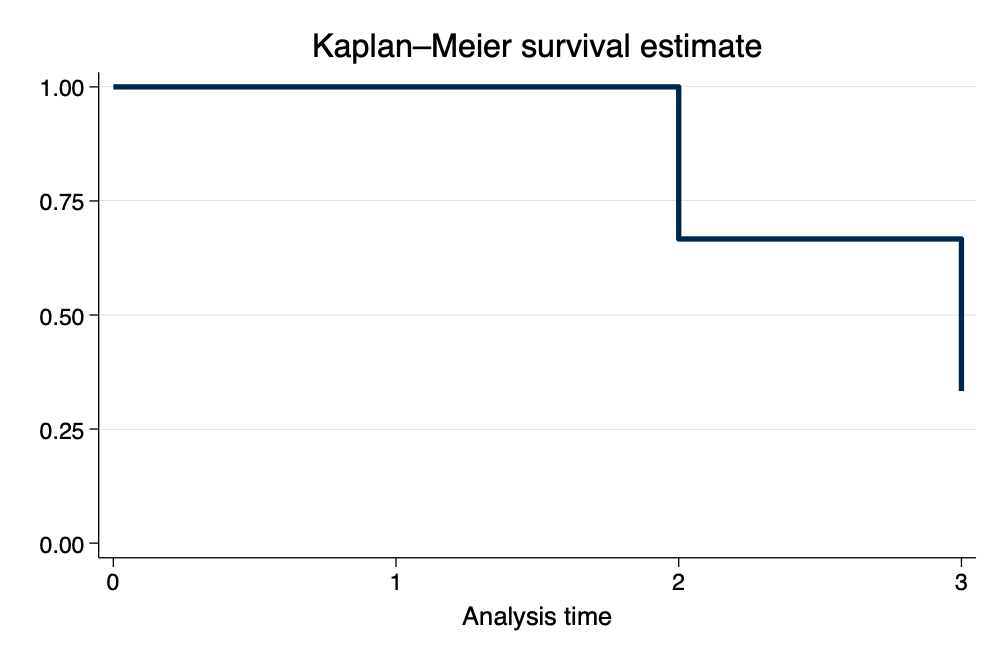
24 Nov 2023
Below you will find a simulated data set that might help you think about constructing a data set for survival analysis, or event history analysis.
These simulated data represent a common situation in which a categorical status (like a diagnosis of depression or PTSD) is observed at different time points.
An event is defined as a (relatively sudden) change from a status of 0 to a status of 1.
These data are in wide format. We will need to think differently if data are in long format.
. clear all
. use "simulated-survival-data.dta", clear
In this example, we are going to think about how to take a data set of statuses and turn it into a data set of events.
Notice how this is a wide data set. Every individual has a single row of data, and information on status at each of the timepoints is contained in the same row.
. list
┌──────────────────────────────────┐
│ id status1 status2 status3 │
├──────────────────────────────────┤
1. │ 1 0 0 0 │
2. │ 2 0 1 1 │
3. │ 3 0 0 1 │
└──────────────────────────────────┘
First, we want to make sure that it is appropriate to conceptualize this data set of individuals as a data set for whom the event has not yet occurred.
Second, we want to create an event time out of these status changes.
Our code might look something as follows.
I am assuming in the code below that waves are 1 year apart, and you might want to adjust your code accordingly if waves are differentially spaced.
. * possibly... only keep observations with nonmissing statuses
. keep if status1 != . & status2 != . (0 observations deleted)
. * initialize to longest time
. * censored observations will have the value of the longest possible event time
. generate event_time = 3
. * change event time to 2 if status2 == 2 . * change event time to 1 if status1 == 1
. * notice that I am doing this in *reverse* order . * to capture the earliest event time
. replace event_time = 2 if status2 == 1 // event time is 2 if status 2 is 1 (1 real change made)
. replace event_time = 1 if status1 == 1 // event time is 1 if status 1 is 1 (0 real changes made)
. * failure becomes 1 for those . * for whom event occurred at some timepoint
. generate failure = 0 // initialize
. * change failure to 1 if any status variable == 1
. replace failure = 1 if status1 == 1 | status2 == 1 | status3 == 1 (2 real changes made)
You can see that our data now have an event time, and a censoring status.
. list, abbreviate(10) // list out the data
┌─────────────────────────────────────────────────────────┐
│ id status1 status2 status3 event_time failure │
├─────────────────────────────────────────────────────────┤
1. │ 1 0 0 0 3 0 │
2. │ 2 0 1 1 2 1 │
3. │ 3 0 0 1 3 1 │
└─────────────────────────────────────────────────────────┘
stset the dataInspection of the results from the stset command indicates that the
data appears to have been stset correctly.
. stset event_time, failure(failure == 1)
Survival-time data settings
Failure event: failure==1
Observed time interval: (0, event_time]
Exit on or before: failure
──────────────────────────────────────────────────────────────────────────
3 total observations
0 exclusions
──────────────────────────────────────────────────────────────────────────
3 observations remaining, representing
2 failures in single-record/single-failure data
8 total analysis time at risk and under observation
At risk from t = 0
Earliest observed entry t = 0
Last observed exit t = 3
. sts graph, scheme(michigan)
Failure _d: failure==1
Analysis time _t: event_time
. graph export simulated-survival-data.png, width(1000) replace
file
/Users/agrogan/Desktop/GitHub/newstuff/categorical/survival-analysis-and-event-hi
> story/simulated-survival-data.png saved as PNG format

Notice how the graph makes intuitive sense if we consider the combination of
event_timeandfailurefor each observation.